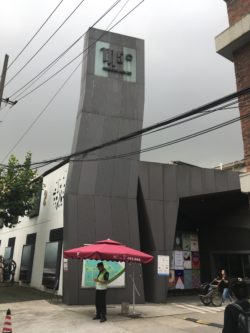Ghost in M50 Host
M50 is a China's first Creative Cluster, representing the formation of China's Creative Industries.
Standing adjacent to Suzhou Creek, which once marked the boundary of Shanghai’s International Settlement. This 23,000 square Contemporary Arts Cluster has its rich history started in 1933 as a cotton warehouse. In 1937, the site was acquired by a businessman from Tsingtao who purchased British machinery and turned it into a full production factory in April 1938. By 1939 the mill had 3000 spindles, 200 looms and employed around 1000 workers. After a brief management under the Japanese occupation, in 1944, the factory was purchased by the Zhou family and named it Xinhe Mill. In 1949, following the formation of the Peoples Republic of China, the mill was renamed the Xinhe Cotton Slub Factory. It changed its name in 1951 to the Xinhe Cotton Spinning Factory and the Xinhe Woollen Spinning Factory in 1961. In 1966, it became the Shanghai No.12 Woollen Spinning Factory, and in 1994 it was renamed as the Shanghai Chunming Slub Corporation. M50 represents the formation and evolution of China's Textile Industry, referred to as China's Mother Industry.
The Shanghai Textile Industry into nurtured China's female working class, whom predominantly are migrants from Zhejiang province. They patroned their home county sing-song form Shaoxinxi in Shanghai which evolved as Shanghai All-female Yueju, a modern theatre form by the mid-1940s. Shanghai Yueju was further nurtured under Mao Zedong's era as a Chinese modern art form, representing China modern female cultural identity.
Following China's nationwide State-Owned-Enterprises (SOE) reform and large scale redundancy, in 1998 the Shanghai Municipal Government commenced the Suzhou Creek Rehabilitation Project, making way for new housing development projects. In 1999 Shanghai Chunming Slub Corporation formally closed its gates. To maintain some income to the site, units were leased to a gathering group of artists, to be used as a Creative Cluster as China transformed from traditional industry to the Creative Industries.
In the early 2000s the site was designated for demolition with the Tian’an Group contracted to replace it with high rise accommodation. The resident artists lobbied the government and were fortunate that the SARS pandemic halted demolition work, allowing them time to develop their preservation argument around the historical importance of the Moganshan block. They were eventually successful and the redevelopment was cancelled. In 2002 the site opened as the Shanghai Chunming Metropolitan Industrial Park. In 2003 it was declared a protected site under Shanghai’s regulations on the preservation of Excellent Historic Architecture. It was renamed as the Chunming Art Industrial Park in 2004 and thereafter in 2005 it became known as the M50 Creative Park, or simply M50. Today, M50 represents China's successful transition of from Made in China to Created in China.
Across the street from M50, at the entrance of Shanghai Textile Museum, is a statue of a female figure with one of her arms broken whilst reaching to the sky with the other. The inscription below reads: Zhuangzhi Duanbi or ‘the martyr breaking one arm to survive’. Director Jiang Guorong, curator of Shanghai Textile Museum, described the painful process of post-industrial transformation as follows:
‘SOE was no longer working and it became the main burden of Shanghai economic transition – first space, second staff. Where the Pearl Tower stands today, the tripod used to be three textile factories. If they were not demolished, Shanghai could not be redesigned. In the early 1990s, there were 550,000 female textile workers, we had to shed them. Today, M50 creative park has only 20 full time employees, but we (Textile Bureau) are still paying around 400,000 pensioners. For Shanghai’s post-industrial transition, China’s Mother Industry, the Textile Industry and its female workers sacrificed themselves’ (Jiang 2020).
As M50 became increasingly famous as a Shanghai Arts Cluster, rental rates for the units inevitably increased from the original 3y/sqm per day to ten times the amount. Apart from the rising rent the artists themselves began to reject the commercialized atmosphere and many left, making way increasingly for bars and restaurants and international art salons creating a high-class market and tourist destination. In 2020 our research team distributed over 200 questionnaires to M50 visitors and local residents, asking if they have knowledge of M50's past history and Shanghai Yueju. Few knows that M50 was once a textile mill (despite plaques with Xinhe Textile Mill written on the wall) and some has heard of Shanghai Yueju; NO one knows the joint fate of the female textile workers and Shanghai Yueju. At the end of a corridor inside M50, there is a mural painting with a group of female textile workers smiling broadly, this is the only remaining history of the textile workers. Only few could hear the sound of their laughter and singing of their beloved yueju, drifting in and around M50 as the lingering ghosts.

Popular performance for new urban audience, reconnecting M50 creative cluster with Shanghai all-female yueju (2018-2021) is an AHRC Newton Fund project, unearth the missing information of the female textile workers and their theatrical form Shanghai Yueju in China's formation of the Creative Industries. This research is led by Dr Haili Ma, in collaboration Shanghai Theatre Academy. More information on the project development can be found at Ghost in M50 Host.
Outputs include The Missing ICH in Shanghai CCI.
Also see the follow-on UKRI/AHRC awards Song of the Female Textile Workers (2020-2022) and Song: The Future (2022-2023).
